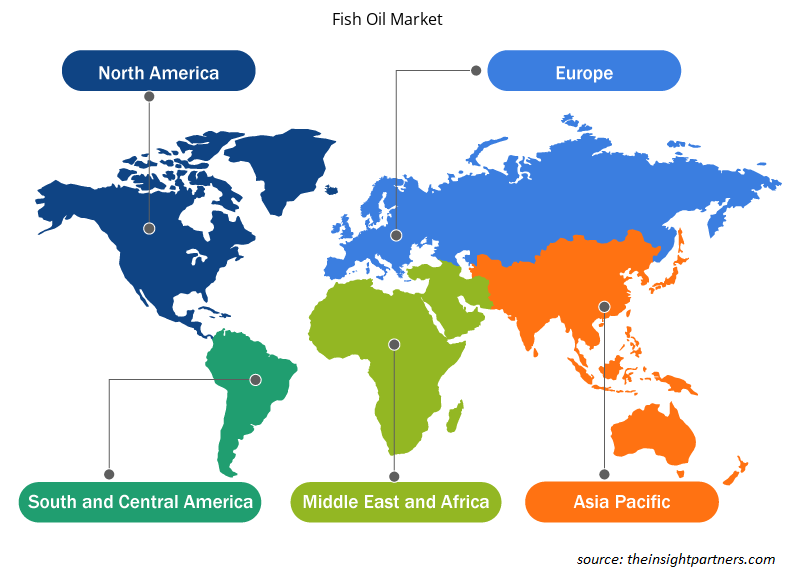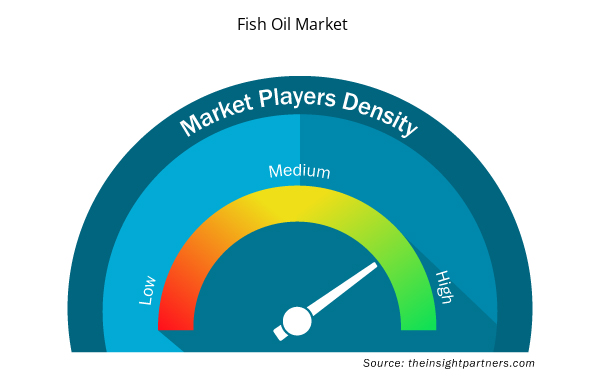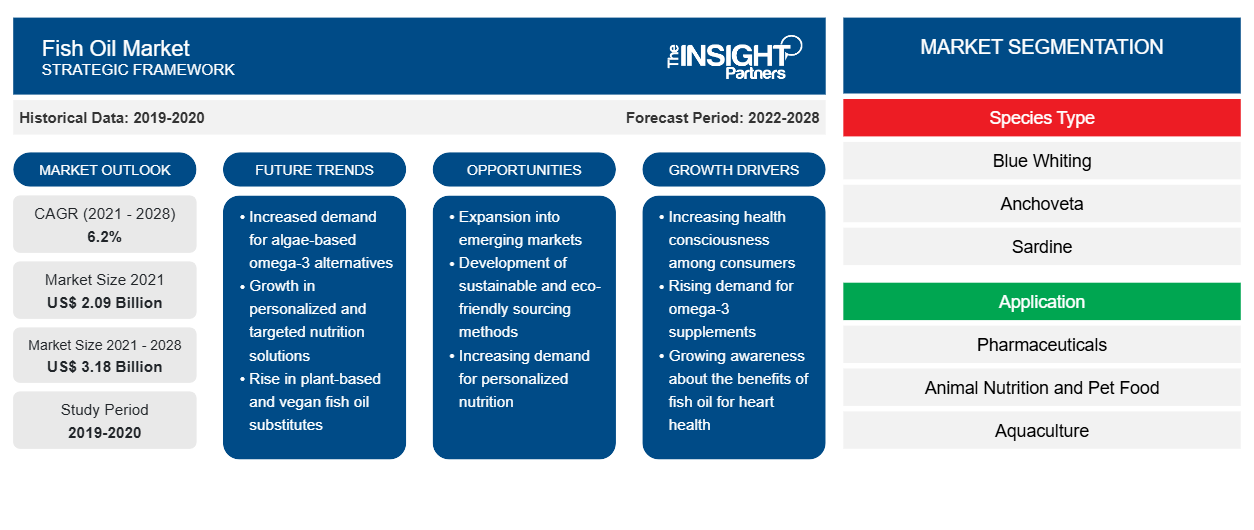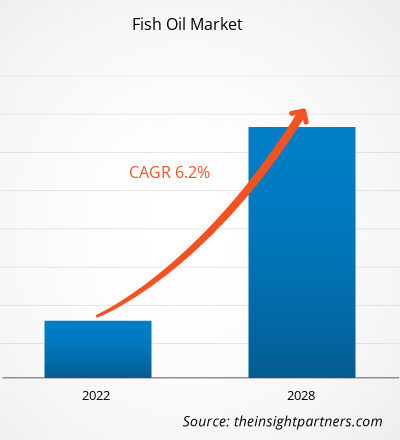Le marché de l'huile de poisson a été évalué à 2 087,39 millions de dollars américains en 2021 et devrait atteindre 3 178,28 millions de dollars américains d'ici 2028. Il devrait croître à un TCAC de 6,2 % de 2021 à 2028.
L'huile de poisson est issue de tissus de diverses espèces de poissons et contient des acides gras oméga-3, tels que les acides eicosapentaénoïques (EPA) et les acides docosahexaénoïques (DHA). Ils offrent divers avantages pour la santé, notamment une réduction du risque de décès dû à une crise cardiaque, à des rythmes cardiaques anormaux dangereux, à une diminution des triglycérides et à des accidents vasculaires cérébraux.
En 2020, l’Asie-Pacifique a dominé le marché mondial de l’huile de poisson et devrait conserver sa domination au cours de la période de prévision. La prise de conscience croissante liée aux bienfaits pour la santé et au riche profil nutritionnel de l’huile de poisson stimule la croissance du marché de l’huile de poisson dans toute la région. Parallèlement à cela, la prévalence accrue des maladies chroniques dans divers pays de la région entraîne une augmentation de la demande d’huile de poisson. Par exemple, en Australie, on estime que cinquante pour cent des Australiens souffrent d’au moins une des huit maladies chroniques courantes sélectionnées : cancer, maladie cardiovasculaire, problèmes de santé mentale, arthrite, maux de dos et problèmes, bronchopneumopathie chronique obstructive, asthme et diabète. Ces facteurs devraient favoriser la croissance de la demande d’huile de poisson dans la région.
Personnalisez ce rapport en fonction de vos besoins
Vous bénéficierez d'une personnalisation gratuite de n'importe quel rapport, y compris de certaines parties de ce rapport, d'une analyse au niveau des pays, d'un pack de données Excel, ainsi que d'offres et de remises exceptionnelles pour les start-ups et les universités.
- Obtenez les principales tendances clés du marché de ce rapport.Cet échantillon GRATUIT comprendra une analyse de données, allant des tendances du marché aux estimations et prévisions.
Informations sur le marché
Large gamme d'applications de l'huile de poisson dans différentes industries
L'huile de poisson est de plus en plus utilisée dans diverses industries, telles que les produits pharmaceutiques, les compléments alimentaires , la nutrition animale et les aliments pour animaux de compagnie . Elle trouve une application importante dans les produits pharmaceutiques et est considérée comme une huile naturelle ou des concentrés d'EPA-DHA. Elle est également utilisée dans l'alimentation animale car elle a des effets favorisant la croissance et constitue une source d'énergie peu coûteuse. En dehors de cela, elle est également utilisée dans les aliments pour animaux de compagnie et aide à renforcer le système immunitaire des chiens tout en aidant à lutter contre le cancer canin. L'huile de poisson est également utilisée comme complément alimentaire où les capsules sont traditionnellement fabriquées à partir de gélatine qui recouvre l'huile dans les capsules molles. Ainsi, l'utilisation de l'huile de poisson dans différentes industries stimule la croissance du marché de l'huile de poisson.
Informations sur les types d'espèces
En fonction du type d'espèce, le marché de l'huile de poisson est divisé en merlan bleu, anchois, sardine, capelan et autres. En 2020, le segment de la sardine était le segment qui a connu la croissance la plus rapide du marché. La sardine est un petit poisson ressemblant au hareng et présentant divers avantages nutritionnels similaires à ceux d'autres poissons tels que le saumon. L'huile extraite de la sardine est également utilisée comme lubrifiant et est principalement utilisée dans les peintures, les vernis, les biocarburants et le linoléum.
Pesquera Exalmar SAA ; Omega Protein Corporation ; Pelagia AS ; Copeinca ; Coplex International SAC ; Triplenine ; FF Skagen A/S ; DSM ; Croda International PLC ; et BASF SE sont les principaux acteurs du marché de l'huile de poisson. Les principaux acteurs adoptent plusieurs stratégies, telles que les fusions et acquisitions et les lancements de produits, pour étendre leur présence géographique et leur base de consommateurs.
Rapports en vedette
- Tendances progressistes dans l'industrie de l'huile de poisson pour aider les acteurs à développer des stratégies efficaces à long terme
- Stratégies de croissance commerciale adoptées par les entreprises pour assurer leur croissance sur les marchés développés et en développement
- Analyse quantitative du marché mondial de l'huile de poisson de 2019 à 2028
- Estimation de la demande en huile de poisson dans diverses industries
- Analyse de Porter pour illustrer l'efficacité des acheteurs et des fournisseurs opérant dans l'industrie pour prédire la croissance du marché
- Développements récents pour comprendre le scénario concurrentiel du marché et la demande d'huile de poisson
- Tendances et perspectives du marché associées aux facteurs qui stimulent et freinent la croissance du marché de l'huile de poisson
- Compréhension des stratégies qui sous-tendent l'intérêt commercial à l'égard de la croissance du marché mondial de l'huile de poisson, aidant au processus de prise de décision
- Taille du marché de l'huile de poisson à différents points du marché
- Aperçu détaillé et segmentation du marché mondial de l'huile de poisson ainsi que de sa dynamique industrielle
- Taille du marché de l'huile de poisson dans diverses régions avec des opportunités de croissance prometteuses
Aperçu régional du marché de l'huile de poisson
Les tendances régionales et les facteurs influençant le marché de l’huile de poisson tout au long de la période de prévision ont été expliqués en détail par les analystes d’Insight Partners. Cette section traite également des segments et de la géographie du marché de l’huile de poisson en Amérique du Nord, en Europe, en Asie-Pacifique, au Moyen-Orient et en Afrique, ainsi qu’en Amérique du Sud et en Amérique centrale.

- Obtenez les données régionales spécifiques au marché de l'huile de poisson
Portée du rapport sur le marché de l'huile de poisson
| Attribut de rapport | Détails |
|---|---|
| Taille du marché en 2021 | 2,09 milliards de dollars américains |
| Taille du marché d'ici 2028 | 3,18 milliards de dollars américains |
| Taux de croissance annuel moyen mondial (2021-2028) | 6,2% |
| Données historiques | 2019-2020 |
| Période de prévision | 2022-2028 |
| Segments couverts | Par type d'espèce
|
| Régions et pays couverts | Amérique du Nord
|
| Leaders du marché et profils d'entreprises clés |
|
Densité des acteurs du marché de l'huile de poisson : comprendre son impact sur la dynamique des entreprises
Le marché de l'huile de poisson connaît une croissance rapide, tirée par la demande croissante des utilisateurs finaux en raison de facteurs tels que l'évolution des préférences des consommateurs, les avancées technologiques et une plus grande sensibilisation aux avantages du produit. À mesure que la demande augmente, les entreprises élargissent leurs offres, innovent pour répondre aux besoins des consommateurs et capitalisent sur les tendances émergentes, ce qui alimente davantage la croissance du marché.
La densité des acteurs du marché fait référence à la répartition des entreprises ou des sociétés opérant sur un marché ou un secteur particulier. Elle indique le nombre de concurrents (acteurs du marché) présents sur un marché donné par rapport à sa taille ou à sa valeur marchande totale.
Les principales entreprises opérant sur le marché de l'huile de poisson sont :
- Pêche Exalmar SAA
- SOCIÉTÉ DE PROTÉINES OMEGA
- PÉLAGIE COMME
- COPEINCA
- COPLEX INTERNATIONAL SAC
Avis de non-responsabilité : les sociétés répertoriées ci-dessus ne sont pas classées dans un ordre particulier.

- Obtenez un aperçu des principaux acteurs du marché de l'huile de poisson
L'analyse du marché mondial de l'huile de poisson jusqu'en 2028 est une étude spécialisée et approfondie de l'industrie des aliments et des boissons, avec un accent particulier sur l'analyse des tendances du marché mondial de l'huile de poisson. Le rapport vise à fournir un aperçu du marché avec une segmentation détaillée du marché. Le marché de l'huile de poisson est analysé sur trois fronts : le type d'espèce, l'application et la géographie. En fonction du type d'espèce, le marché est divisé en merlan bleu, anchois, sardine, capelan et autres. En fonction de l'application, le marché de l'huile de poisson est divisé en produits pharmaceutiques, nutrition animale et aliments pour animaux de compagnie, aquaculture, compléments alimentaires et autres. En fonction de la géographie, le marché de l'huile de poisson est segmenté en cinq régions principales : l'Amérique du Nord, l'Europe, l'Asie-Pacifique, le Moyen-Orient et l'Afrique, et l'Amérique du Sud et l'Amérique centrale.
Profils d'entreprise
- BASF SE
- Copeinça
- Coplex International SAC
- Croda International PLC
- DSM
- FF Skagen A/S
- Société de protéines Omega
- Pélagie AS
- Pêcheur Exalmar SAA
- Triplenine
- Analyse historique (2 ans), année de base, prévision (7 ans) avec TCAC
- Analyse PEST et SWO
- Taille du marché Valeur / Volume - Mondial, Régional, Pays
- Industrie et paysage concurrentiel
- Ensemble de données Excel


- Medical and Research Grade Collagen Market
- Smart Water Metering Market
- Collagen Peptides Market
- Print Management Software Market
- Vessel Monitoring System Market
- Hydrolyzed Collagen Market
- Single-Use Negative Pressure Wound Therapy Devices Market
- Skin Graft Market
- Microplate Reader Market
- Thermal Energy Storage Market

Report Coverage
Revenue forecast, Company Analysis, Industry landscape, Growth factors, and Trends

Segment Covered
This text is related
to segments covered.

Regional Scope
North America, Europe, Asia Pacific, Middle East & Africa, South & Central America

Country Scope
This text is related
to country scope.
Questions fréquemment posées
Based on species type, the sardine segment was the fastest-growing segment in the market. Sardine is a small, herring-like fish with various nutritional benefits similar to other species such as salmon. The oil extracted from sardine is also used as a lubricant and is mostly used in paints, varnishes, biofuels, and linoleum.
In 2020, the blue whiting segment accounted for the largest fish oil market share, based on species type. Blue whiting is one of the cod family species and one of the most abundant fish stocks in the semi-pelagic water masses of the Northeast Atlantic. The fish oil derived from blue whiting is a potential source of omega-3 fatty acids.
The market for the pharmaceuticals segment is expected to grow at a faster pace during the forecast period. In various countries, such as Japan, the consumption of nutritional and pharmaceutical-grade fish oil is significantly increasing due to the surge in the presence of the geriatric population, which is likely to result in the rise in demand for pharmaceutical-grade fish oil for various health benefits.
Fish oil is associated with various health benefits and helps in reducing the risk of cardiovascular diseases, lowers blood pressure, and slows the buildup of atherosclerotic plaques. Fish oil is also considered one of the valuable nutrients for both humans and livestock. Fish liver oil and fish body oil are the two types of fish oil. Fish oil is a rich source of Omega-3 fatty acids and includes the presence of vitamins and minerals, such as vitamin A and vitamin D, which are essential for the human body. In addition, the DHA present in fish oil improves memory and cognitive function and plays an important role in the development of an infant's brain. Thus, such health benefits are increasing the demand for fish oil across the world.
The major key players operating in the global fish oil market include Pesquera Exalmar S.A.A.; Omega Protein Corporation; Pelagia AS; Copeinca; Coplex International S.A.C; Triplenine; FF Skagen A/S; DSM; Croda International PLC; and BASF SE.
In 2020, Asia Pacific dominated the global fish oil market. The region is expected to continue its dominance during the forecast period. Trends in this market are influenced by the increasing awareness about the health benefits of omega-3, present abundantly in fish oil. Omega-3 fatty acids are beneficial for the geriatric population as it helps in reducing the risk of chronic diseases and provide preventive measures in terms of heart, cognitive, eye, and joint deterioration.
Trends and growth analysis reports related to Consumer Goods : READ MORE..
The List of Companies - Global Fish Oil Market
- PESQUERA EXALMAR S.A.A.
- OMEGA PROTEIN CORPORATION
- PELAGIA AS
- COPEINCA
- COPLEX INTERNATIONAL S.A.C
- TRIPLENINE
- FF SKAGEN A/S
- DSM
- CRODA INTERNATIONAL PLC
- BASF SE
The Insight Partners performs research in 4 major stages: Data Collection & Secondary Research, Primary Research, Data Analysis and Data Triangulation & Final Review.
- Data Collection and Secondary Research:
As a market research and consulting firm operating from a decade, we have published and advised several client across the globe. First step for any study will start with an assessment of currently available data and insights from existing reports. Further, historical and current market information is collected from Investor Presentations, Annual Reports, SEC Filings, etc., and other information related to company’s performance and market positioning are gathered from Paid Databases (Factiva, Hoovers, and Reuters) and various other publications available in public domain.
Several associations trade associates, technical forums, institutes, societies and organization are accessed to gain technical as well as market related insights through their publications such as research papers, blogs and press releases related to the studies are referred to get cues about the market. Further, white papers, journals, magazines, and other news articles published in last 3 years are scrutinized and analyzed to understand the current market trends.
- Primary Research:
The primarily interview analysis comprise of data obtained from industry participants interview and answers to survey questions gathered by in-house primary team.
For primary research, interviews are conducted with industry experts/CEOs/Marketing Managers/VPs/Subject Matter Experts from both demand and supply side to get a 360-degree view of the market. The primary team conducts several interviews based on the complexity of the markets to understand the various market trends and dynamics which makes research more credible and precise.
A typical research interview fulfils the following functions:
- Provides first-hand information on the market size, market trends, growth trends, competitive landscape, and outlook
- Validates and strengthens in-house secondary research findings
- Develops the analysis team’s expertise and market understanding
Primary research involves email interactions and telephone interviews for each market, category, segment, and sub-segment across geographies. The participants who typically take part in such a process include, but are not limited to:
- Industry participants: VPs, business development managers, market intelligence managers and national sales managers
- Outside experts: Valuation experts, research analysts and key opinion leaders specializing in the electronics and semiconductor industry.
Below is the breakup of our primary respondents by company, designation, and region:

Once we receive the confirmation from primary research sources or primary respondents, we finalize the base year market estimation and forecast the data as per the macroeconomic and microeconomic factors assessed during data collection.
- Data Analysis:
Once data is validated through both secondary as well as primary respondents, we finalize the market estimations by hypothesis formulation and factor analysis at regional and country level.
- Macro-Economic Factor Analysis:
We analyse macroeconomic indicators such the gross domestic product (GDP), increase in the demand for goods and services across industries, technological advancement, regional economic growth, governmental policies, the influence of COVID-19, PEST analysis, and other aspects. This analysis aids in setting benchmarks for various nations/regions and approximating market splits. Additionally, the general trend of the aforementioned components aid in determining the market's development possibilities.
- Country Level Data:
Various factors that are especially aligned to the country are taken into account to determine the market size for a certain area and country, including the presence of vendors, such as headquarters and offices, the country's GDP, demand patterns, and industry growth. To comprehend the market dynamics for the nation, a number of growth variables, inhibitors, application areas, and current market trends are researched. The aforementioned elements aid in determining the country's overall market's growth potential.
- Company Profile:
The “Table of Contents” is formulated by listing and analyzing more than 25 - 30 companies operating in the market ecosystem across geographies. However, we profile only 10 companies as a standard practice in our syndicate reports. These 10 companies comprise leading, emerging, and regional players. Nonetheless, our analysis is not restricted to the 10 listed companies, we also analyze other companies present in the market to develop a holistic view and understand the prevailing trends. The “Company Profiles” section in the report covers key facts, business description, products & services, financial information, SWOT analysis, and key developments. The financial information presented is extracted from the annual reports and official documents of the publicly listed companies. Upon collecting the information for the sections of respective companies, we verify them via various primary sources and then compile the data in respective company profiles. The company level information helps us in deriving the base number as well as in forecasting the market size.
- Developing Base Number:
Aggregation of sales statistics (2020-2022) and macro-economic factor, and other secondary and primary research insights are utilized to arrive at base number and related market shares for 2022. The data gaps are identified in this step and relevant market data is analyzed, collected from paid primary interviews or databases. On finalizing the base year market size, forecasts are developed on the basis of macro-economic, industry and market growth factors and company level analysis.
- Data Triangulation and Final Review:
The market findings and base year market size calculations are validated from supply as well as demand side. Demand side validations are based on macro-economic factor analysis and benchmarks for respective regions and countries. In case of supply side validations, revenues of major companies are estimated (in case not available) based on industry benchmark, approximate number of employees, product portfolio, and primary interviews revenues are gathered. Further revenue from target product/service segment is assessed to avoid overshooting of market statistics. In case of heavy deviations between supply and demand side values, all thes steps are repeated to achieve synchronization.
We follow an iterative model, wherein we share our research findings with Subject Matter Experts (SME’s) and Key Opinion Leaders (KOLs) until consensus view of the market is not formulated – this model negates any drastic deviation in the opinions of experts. Only validated and universally acceptable research findings are quoted in our reports.
We have important check points that we use to validate our research findings – which we call – data triangulation, where we validate the information, we generate from secondary sources with primary interviews and then we re-validate with our internal data bases and Subject matter experts. This comprehensive model enables us to deliver high quality, reliable data in shortest possible time.


 Obtenez un échantillon gratuit pour ce rapport
Obtenez un échantillon gratuit pour ce rapport